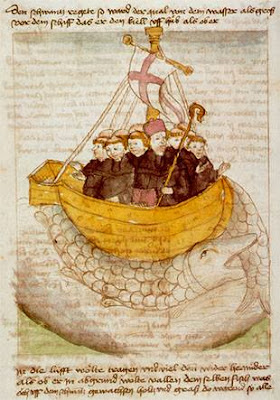To Hell or to Connacht!
Such was Oliver Cromwell's dire dictate to Catholic landowners during the Cromwellian wars in Ireland 1641-1653, after which 90% of all land-ownership was transferred, at the point of a sword, on pain of death, from Irish and Anglo-Norman, mainly Catholic ownership, to English Soldier/Dissenter/Opportunist Protestant ownership. Dispossessed families, many previously wealthy and important, in a refugee state, found themselves forced into the margins of Connacht, mainly Clare, Galway and Mayo, onto land that was at best marginal, hillsides and bogs, and so began the enforced impoverishment of the last great civilisation of Europe, an impoverishment that peaked with the willful genocide that was The Great Hunger, the 10 years of famine in Ireland in the 1840's and 1850's, when 1.5 million people died and 2.5 million emigrated from Ireland, mainly from the western wetlands of Connacht. Picturesque it is but arable it is not.
Most families subsisted on holdings of less than 5 acres in County Galway, with an artificially crowded density of over 500 people per square mile in some areas, totally unsustainable when one considers that they could only grow potatoes on the land, no cereal and had few animals. What animals they had, a pig and maybe a few sheep and rough cattle were kept to pay the rents on their small-holdings. Rack-rents were exorbitant and if the tenant farmer made any improvements he was punished for his industry by having to pay a higher rent the following year. It was a dire lifestyle, one that came crashing down when the potato crop failed.
Yet life continued and a pride in being a Connacht person was always stirring below the surface, a kind of stoic and indomitable spirit. Today Connacht still has poor land but industry is thriving and tourism is particularly healthy, mainly because of the stark and beautiful landscape. Perhaps Cromwell did us a favour after all. But it was a high price to pay, no doubt about that.
Tonight, the Connacht Rugby team who are based in Galway city, play Edinburgh in Murrayfield stadium, in Edinburgh, Scotland, within sight of Balmoral Castle, summer home to the British Royals, who played no small part in Ireland's subjugation and annexation as a British colony, for 700 years. Something to dwell on when the two teams meet tonight. Sport is just another form of war, thankfully with none of the associated devastation.
The West's Awake, but we always remember our past. For more info on the history of Galway or to spend an hour on one of my walking tours 'Galway's Horrible Histories Walks' see http://www.galwaywalks.com
Walking Tours with a difference. Fun, witty and engaging. A combination of entertainment, history and local knowledge.... and not too serious! Hop-on guide. Pub Tours. Once off tailored tours. Check out my website at http://www.galwaywalks.com Follow me on Twitter @Galwaywalks Instagram @Galway_Walks Brian Nolan galwaywalks@gmail.com
Friday 29 November 2013
To Hell or to Connacht
Labels:
Clare,
Connacht,
Cromwell,
Edinburgh,
famine,
galway,
Galway Walks,
Galway's Horrible Histories Walks,
galwaywalks.com,
great hunger,
ireland,
Mayo,
potato,
potatoes,
Scotland,
Tenant
Wednesday 27 November 2013
So, exactly who was it that first discovered America?
On the Galway's Horrible Histories Walk, I weave the Brendan Voyage tale into the stories I tell, explaining how in 929 AD the Vikings raided the Priory Abbey of Annaghdown, 4 miles up the Corrib River from Galway city, which was founded by St. Brendan for his sister, Briga, and where he died in 577 AD. Some time around 531 AD St. Brendan sailed to America with fourteen monks in a leather boat/coracle. He made it home, miraclously, ten years later and penned a best-seller manuscript recounting his voyage called 'De Navigatio Sancti Brendani Abbatis'. (some 100 versions of this manuscript exist in museums and libraries all over Europe). A copy of Brendan's book was looted by the Vikings in their raid on Annaghdown (or possibly when they raided Clonfert, where Brendan is buried) and hey, guess what, some eighty years after the book was stolen, Leif Eriksson 'discovered' America around 1,012 AD ... funny how he never mentioned the book that his grand-dad, Eric the Red, had nicked when he visited Galway...! (He didn't pay the Library Fine either...must be enough to bail out the Irish economy by now!).
Anyway, fully 400 years later, around 1483 a certain sailor named Christopher Columbus visited Galway, as captain of a trading ship, from Coruna and on visiting the Church of St. Nicholas, he too borrowed a copy of Brendan's manuscript and yes, you guessed it, nine years later he was telling Queen Isabella that way out there in the west was a land filled with wondrous stuff, which he was eager to discover for her, entirely of course omitting that he too was following in the very large and confident footsteps of St. Brendan. (yes, I know St. Brendan was from Kerry, but he really only came into his own when he came to Galway, and that's a true story)
St. Brendan's feast day is celebrated on May 16, but you can also celebrate his birthday, on 27 November.
If you care to see how world explorer Tim Severin proved that St. Brendan could have discovered America in a hide and wattle boat, watch the video below ... it truly is an inspiring story.
Ever find yourself in Galway with an hour or two to spare, call me at 086-3273560 or email me at galwaywalks@gmail.com and we can walk and talk together, exploring Galway's Horrible Histories. It's a lot of fun, trust me. Galway Walks http://www.galwaywalks.com
Labels:
Christopher Columbus,
Clonfert,
Columbus,
Coruna,
galway,
Leif Eriksson,
manuscript,
Navigatio' Annaghdown,
Queen Isabella,
Saint Brendan,
St. Brendan,
St. Nicholas,
Vikings
Subscribe to:
Posts (Atom)


